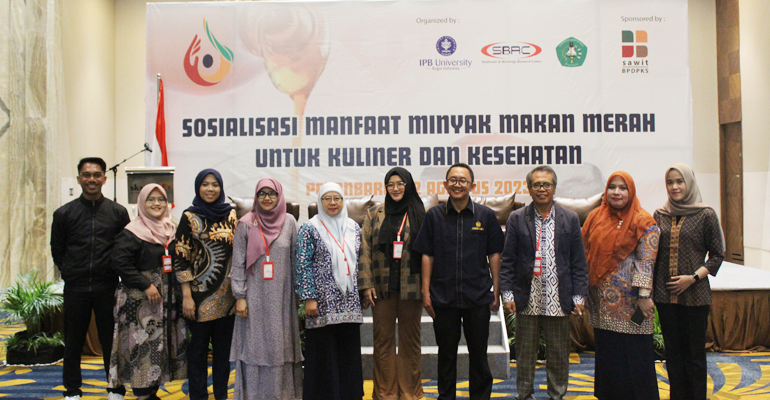BPDPKS Collaborates with IPB University to Socialise the Benefits of Red Edible Oil in Pekanbaru for Stunting Prevention

Following its success in Bandung, the Surfactant and Bioenergy Research Centre (SBRC) of IPB University together with the Palm Oil Plantation Fund Management Agency (BPDPKS) held another socialisation event on the benefits of red cooking oil for culinary and health in Pekanbaru, Riau on Tuesday (22/8) at the SKA Co Ex Building in Pekanbaru.
Dr Dwi Setyaningsih, Secretary of SBRC IPB University, said that the purpose of this socialisation was to make people aware of the health benefits of red cooking oil from palm oil because of the content contained in it. The content of pro-vitamin A in the form of carotene and vitamin E, especially tocotrienols in red cooking oil is not found in other vegetable oils.
“Red cooking oil production can be done on a small scale by small, medium and cooperative enterprises (SMEs). Besides the main product, the by-products such as shells, fibre and palm sludge can be used for fuel or fish feed. Even the leaves can be used for palm tea and value-added brooms to support the circular economy of local communities,” he said.
Chairman of the UKMK Division of BPDPKS, Helmi Muhansyah said that the activity in Riau this time was to promote red cooking oil for health and culinary purposes. He said that the ordinary cooking oil that is currently developed does not contain vitamin A and vitamin E.
“We know that what is currently developing is ordinary cooking oil which does not contain vitamin A and E. But red cooking oil contains both vitamins. But this red cooking oil contains a lot of both vitamins. The public must know, because this is related to the government’s programme to reduce stunting. This red cooking oil has the benefit of reducing stunting because of its vitamin content,” he said.
On an industrial scale, Helmi continued, the government through the Ministry of Cooperatives and SMEs has prepared three pilots in North Sumatra and is currently running. While for medium and small scale, research is still being conducted at various study centres.
This socialisation aims to provide an understanding to the public regarding the benefits of red palm oil and it is hoped that SMEs can implement it. Helmi is optimistic that red palm oil can be produced in Riau, which is the largest palm oil production centre in Indonesia. However, he said that it is important that the community is given an understanding of red palm oil.
“Because people must understand first, in terms of appearance it is different, it is red in colour. But in terms of benefits, red palm oil is very useful. So we socialise its benefits first,” Helmi said.
In the socialisation activity, the participants were given various explanations including the health benefits and presentation of red palm oil, Crude Palm Oil (CPO) and red cooking oil production technology. Not only that, participants also gained knowledge about the development of red palm oil derivative products as well as the potential and business analysis of red palm oil that can be produced at the level of farmers or palm oil cooperatives.
This activity was attended by various parties including related agencies, academics from various universities in Riau, associations of oil palm farmers and SMEs. The Department of Agricultural Product Technology, Faculty of Agriculture, Lancang Kuning University also participated in assisting the event. (*/Rz)



















